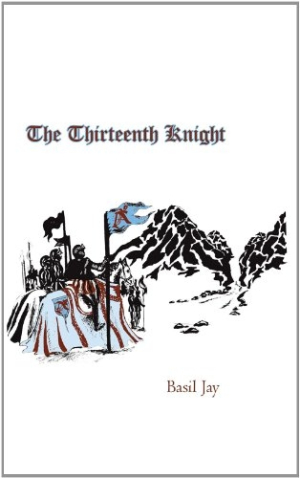The Thirteenth Knight
To marry up fantasy fiction with a well-known folk tale and make it accessible to a young audience while still keeping it interesting for adults is a daunting task of Arthurian proportion—and one performed with grace and charm by Basil Jay in The Thirteenth Knight.
Although its start is little slow, the story quickly pulls readers in, especially those who grew up reading Sir Thomas Mallory and T. H. White. Jay is not of their caliber, but it is obvious they were at least his role models and inspiration, and had either of them been Jay’s teacher, they would certainly give this student high marks.
Jay has three heroes in his book—two of them boys, Pimm and Jeremy, and one a knight, the chivalric Prince Gemree. Mounted upon his noble charger Swiftsure, Prince Gemree goes on a great quest to save the kingdom. Two of his adventures are especially enjoyable: the first is along the lines of St. George and the dragon and is a battle that is so involved it takes two chapters to complete. Even better is Prince Gemree’s combat with the Great Knight who, of course, is armored cap-a-pie in black. This latter episode is satisfyingly reminiscent of The Tale of Sir Gareth, specifically the portion of that classic Arthurian legend where the hero engages the Red Knight of the Red Launds.
There is a final epic battle that makes for a great read on its own—something like a knightly twenty-four Horatios at the bridge or an Arthurian version of the Spartans at the Hot Gates. Despite a rather hokey Narnia-like transition (with a rock and a river instead of a closet), it is all good, satisfying fun.
Jay writes in a simple, uncomplicated style that any young reader of age twelve or so could easily follow, yet in a manner that even hard-core Arthurian fans will enjoy. This is not a deep book and, at just shy of three hundred pages, can easily be finished off in two or three sittings. The three stories mentioned above, however, with the dragon, the Great Knight, and the big battle, are the kind of stand-alone chapters that fans mark to read again later, when they need a little pick-me-up, a diversion, or a bedtime story (for their kids or for themselves).
Unfortunately, Jay’s work does contain some rather obvious flaws in the text. There are reversed letters, dropped letters, and homonym errors—armies come on in “hordes,” not in “hoards.” There is also a missing illustration, as noted by an “insert image” instruction in bold type and large double brackets on page twelve. These simple errors do not break the book, but they do detract from the read. And the cover contains a visual error: there are three knights with banners—two of the banners fly to the left, but the other flies to the right, at odds with the others.
The cover could be meant as a riddle, a puzzle, or an inside joke, but the typographical errors cannot be so easily dismissed. Despite these mistakes, however, The Thirteenth Knight is a joy to read, a bedtime story and fairy tale for children of all ages, and a must for any who like fantasies that remind them of the Arthurian age.
Reviewed by
Mark McLaughlin
Disclosure: This article is not an endorsement, but a review. The publisher of this book provided free copies of the book and paid a small fee to have their book reviewed by a professional reviewer. Foreword Reviews and Clarion Reviews make no guarantee that the publisher will receive a positive review. Foreword Magazine, Inc. is disclosing this in accordance with the Federal Trade Commission’s 16 CFR, Part 255.

